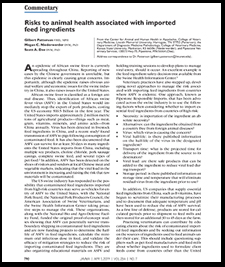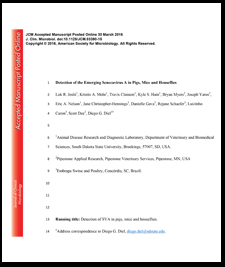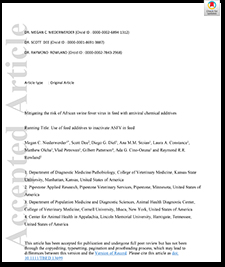An evaluation of porcine epidemic diarrhea virus survival in individual feed ingredients in the presence or absence of a liquid
antimicrobial
Contaminated complete feed and porcine plasma are risk factors for PEDV introduction to farms and
a liquid antimicrobial has been proven useful for reducing risk.
This study provides information on the survivability of PEDV across common swine feed ingredients in the presence or absence of the liquid antimicrobial.
Risks to animal health associated with imported feed ingredients
An epidemic of African swine fever is currently spreading throughout China. Reporting of new cases by the Chinese government is unreliable, but this epidemic is clearly causing great concerns.
Importantly, although the epidemic raises obvious animal welfare and economic issues for the swine industry in China, it also raises issues for the United States.
Detection of the Emerging Senecavirus A in Pigs, Mice and Houseflies
Senecavirus A (SVA) is an emerging picornavirus that has been recently associated with increased outbreaks of vesicular disease and neonatal mortality in swine. Many aspects of SVA infection biology and epidemiology remain unknown.
Here, we present a diagnostic investigation conducted in swine herds affected by vesicular disease and increased neonatal mortality.
Mitigating the risk of African swine fever virus in feed with antiviral chemical additives
African swine fever (ASF) is currently considered the most significant global threat to pork production worldwide. ASFV is transmissible through natural consumption of contaminated swine feed and is broadly stable across a wide range of commonly imported feed ingredients and conditions.
The objective of the current study was to investigate the efficacy of medium chain fatty acid and formaldehyde based feed additives in inactivating ASFV. This study provides evidence that chemical feed additives may potentially serve as mitigants for reducing the risk of ASFV introduction and transmission through feed.




